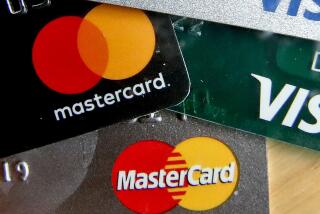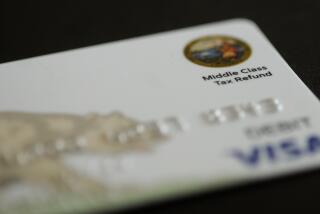On the Spot: Having extra protection from credit cards can be like money in the bank
Sure, travel rewards credit cards can get you a free ticket or nights in a hotel that you might not otherwise be able to afford. Who wouldn’t be bedazzled by that?
But these cards are more than just a pretty face. Many have benefits that you don’t think about, maybe because you don’t know about them. In fact, according to a recent CompareCards survey, almost half of card holders don’t use the benefits.
How do you know what they are? This is where it pays to be a bit nerdy. Remember that booklet you received with your card? It’s a gold mine of information. But you may have put it away rather than spend a scintillating evening reading the fine print.
You might want to fish it out.
“A lot of the benefits aren’t advertised,” said Brian Karimzad, vice president of research for CompareCards.com. “You often won’t see these benefits labeled even on the credit-card companies’ websites.
“You have to open the pamphlet that you get in the mail to see what you are entitled to.”
If you don’t have the pamphlet, a call to your credit card company may help you uncover your benefits.
One big caveat: You must have used your card to get the benefits. Here are some of them.
--Cellphone replacement in case your device is damaged and dies. I was going to start with insurance, but you would have stopped reading because that’s just so DBI — dull but important. So let’s talk about this sexy little perk.
It’s a relatively recent entry in the benefits derby, Karimzad said. “It’s legitimate coverage,” he said, but “it’s probably not as robust as your carrier’s plan.” (You can buy coverage from your provider.)
If you have an iPhone X, it may not cover the full cost, because typically, he said, the “max is going to be $500 to $600.”
Also, the damage must be “catastrophic,” he said. You may not be covered for, say, a broken screen.
If your phone is stolen, make sure you get a police report, then ask your card company if it’s covered.
The caveat: You generally “need to pay for your monthly cellphone bill with the card to activate coverage,” Karmizad said.
--Trip delay or cancellation. You are traveling in the spring and a giant thunderstorm grounds your flight. You end up spending the night in (fill in the blank). Airlines typically don’t cover your lodging or meals.
Or you can’t make the trip and you’d like to recoup some of your costs. If you don’t have an insurance policy that covers this (please don’t stop reading just because I said the “I” word), your credit card might.
Chase Sapphire Reserve, which has been red hot since its introduction in 2016, not only explains this benefit but also lets you download the booklet (www.chasebenefits.com/sapphirereserve). Here’s the good news: You and your immediate family are covered, and Chase has a wide-ranging definition of who this includes: grandparents, grandkids, aunts and uncles and more.
The caveat: You must have used the card to pay for the trip.
Rental cars. This is the insurance part. I promise there’s at least one other interesting tidbit after this, but this is important and I promise not to use words such as “collision damage waiver.”
No one likes to be strong-armed into buying rental car company insurance, especially if you have your own.
And you don’t have to. If you already have auto insurance, you’re generally golden. But many cards offer secondary insurance, which is the mop-up feature once your primary insurance is tapped.
Other cards — and these tend to be higher end — offer primary insurance. That means you can file a claim with the card’s insurer and your own auto insurance company will not have to foot the bill — and may not even know you’ve had an accident. Result? Rates may stay flat.
The caveat: You have the coverage that comes with the card you booked with. If you don’t have auto insurance because you don’t own or lease a personal vehicle, a card can provide primary coverage that will keep you well protected. A card with secondary coverage may help too but you must ask your card company. Take lots of notes.
Price protection. This has little to do with travel, unless you are buying something big while you’re away. If the price drops on something you’ve bought, you may be entitled to the difference.
Caveat: Must.Use.Card.To.Buy
The final two caveats: First, document everything. If it’s an official document, keep it. You may need it. If your flight is canceled, ask a gate agent to provide something that shows you’ve been reaccommodated (not a new boarding pass). Keep your receipts for whatever you purchase, whether it’s a new phone or a big-screen TV whose price drops by hundreds.
Second, compare what cards offer before you select one. You can do so at CompareCards (lat.ms/comparecards), NerdWallet (lat.ms/nerdpicks), WalletHub (lat.ms/wallethubcards) and others.
Perhaps most heartening, CompareCards’ survey shows that more than three-quarters of card holders received all the money they were due for their claims, which averaged a little more than $1,500.
We may think of credit cards as something that enables us to spend, but for many travelers, they also can be like money in the bank.
Have a travel dilemma or question? Write to [email protected]. We regret we cannot answer every inquiry.
More to Read
Sign up for The Wild
We’ll help you find the best places to hike, bike and run, as well as the perfect silent spots for meditation and yoga.
You may occasionally receive promotional content from the Los Angeles Times.







